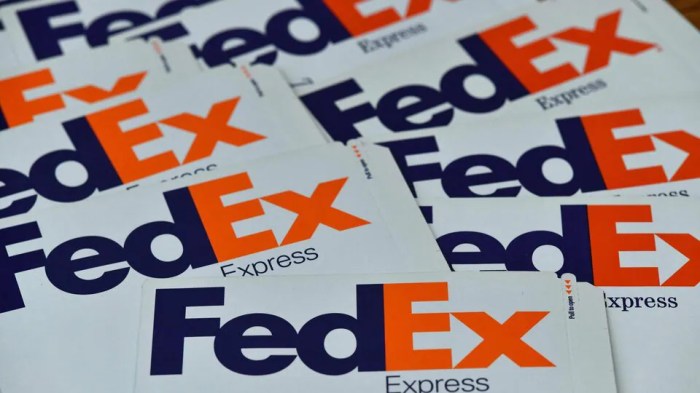FedEx cuts full-year guidance, sending shares lower premarket, signaling a challenging period for the shipping giant. The company’s revised outlook, a stark contrast to its previous optimistic projections, reflects a confluence of factors that are impacting the logistics industry.
From slowing global economic growth to persistent supply chain disruptions, FedEx is grappling with headwinds that are forcing it to adjust its course.
The market reacted swiftly to the news, sending FedEx’s stock price tumbling in premarket trading. Investors, concerned about the company’s ability to navigate these challenges, are weighing the implications for FedEx’s profitability and future growth. The guidance revision serves as a stark reminder of the volatility and uncertainty that continue to plague the global economy and the businesses that operate within it.
FedEx’s Financial Performance

FedEx’s recent announcement of a reduced full-year guidance has sent shockwaves through the market, causing its shares to plummet in pre-market trading. This downward revision in guidance paints a stark picture of the challenges the company is facing, highlighting a weakening global economy and a persistent shift in consumer spending patterns.
Impact on Financial Outlook
The revised guidance signals a significant shift in FedEx’s financial outlook. The company now expects to see a decline in both revenue and earnings for the fiscal year, a stark contrast to the initial expectations. This downward revision reflects a pessimistic view of the global economic landscape, suggesting that FedEx anticipates a slowdown in global trade and a continued decline in consumer demand.
This, in turn, will impact its profitability and growth prospects.
Factors Contributing to Revised Guidance
Several factors have contributed to FedEx’s revised guidance. These include:
- Weakening Global Economy:The global economy is facing significant headwinds, with rising inflation, interest rates, and geopolitical tensions. This has resulted in a slowdown in global trade, impacting demand for FedEx’s services.
- Shifting Consumer Spending:Consumer spending patterns have shifted towards experiences and services, impacting demand for goods and, consequently, for shipping services. This trend has negatively impacted FedEx’s business.
- Increased Competition:The shipping industry is becoming increasingly competitive, with new players emerging and established players expanding their services. This competition puts pressure on FedEx’s pricing and margins.
- Operational Challenges:FedEx has also faced operational challenges, including labor shortages and supply chain disruptions. These challenges have impacted its efficiency and profitability.
Implications for Profitability and Growth Prospects
The revised guidance has significant implications for FedEx’s profitability and growth prospects. The company’s earnings are expected to decline, impacting its ability to invest in future growth. The slowdown in global trade and shifting consumer spending patterns may also lead to reduced revenue growth in the future.
This, in turn, could put pressure on FedEx’s profitability and its ability to compete effectively in the long term.
Market Reactions and Investor Sentiment: FedEx Cuts Full-year Guidance, Sending Shares Lower Premarket

The announcement of FedEx’s revised guidance sent shockwaves through the market, immediately impacting the company’s stock price. Shares of FedEx plunged in pre-market trading, reflecting investors’ concerns about the company’s financial outlook. This downturn highlights the significant impact of the company’s financial performance on investor sentiment.
Investor Sentiment and Stock Price Decline
The immediate market reaction to FedEx’s announcement reflects a palpable shift in investor sentiment. The stock price decline indicates a loss of confidence in FedEx’s ability to meet previous financial targets. This sentiment is likely driven by several factors, including:* Diminished Earnings Expectations:The revised guidance signals a downward trend in FedEx’s financial performance, raising concerns about future profitability.
Economic Uncertainty
The global economic landscape is characterized by ongoing inflation, supply chain disruptions, and geopolitical tensions, creating a challenging environment for businesses like FedEx.
Competition
FedEx faces intense competition in the logistics industry, with rivals like UPS and Amazon aggressively vying for market share.
“The stock price decline suggests a loss of confidence in FedEx’s ability to meet previous financial targets. This sentiment is likely driven by several factors, including diminished earnings expectations, economic uncertainty, and competition.”
Browse the multiple elements of Masimo gains as activist Politan wins two board seats to gain a more broad understanding.
Industry Context and Competitive Landscape
The FedEx guidance revision reflects a broader shift in the logistics and shipping industry, characterized by evolving consumer expectations, heightened competition, and economic uncertainties. This section delves into these trends, examines FedEx’s competitive landscape, and explores the potential impact of its guidance revision on the industry as a whole.
Industry Trends
The logistics and shipping industry is experiencing a confluence of factors shaping its trajectory. These include:
- E-commerce Growth:The rise of online shopping has fueled demand for efficient and reliable delivery services. Consumers expect fast and convenient shipping options, driving logistics companies to invest in infrastructure and technology to meet these expectations.
- Supply Chain Disruptions:Global events, such as the COVID-19 pandemic and geopolitical tensions, have disrupted supply chains, leading to increased costs, delays, and volatility. Logistics companies are adapting to these challenges by enhancing their network resilience and exploring alternative sourcing strategies.
- Automation and Technology:Automation technologies, such as robotics and artificial intelligence, are being implemented to improve efficiency, reduce labor costs, and enhance tracking and visibility. This trend is reshaping the industry, leading to job displacement in some areas while creating new opportunities in others.
- Sustainability Focus:Environmental concerns are driving a shift towards sustainable practices in the logistics industry. Companies are adopting greener delivery methods, reducing emissions, and implementing sustainable packaging solutions to meet growing consumer demand for eco-friendly options.
Competitive Landscape
FedEx operates in a highly competitive landscape, facing stiff competition from other major players such as:
- UPS:UPS is FedEx’s primary competitor, offering a similar range of services and operating a global network. Both companies are engaged in a fierce battle for market share, with UPS often focusing on ground delivery while FedEx emphasizes air freight.
- Amazon:Amazon’s entry into the logistics market has significantly impacted the industry. With its vast network of fulfillment centers and delivery infrastructure, Amazon is a formidable competitor, offering competitive pricing and fast delivery options. This has pressured traditional logistics companies to innovate and improve their offerings.
- Smaller Regional Carriers:Numerous smaller regional carriers cater to specific geographic areas or specialized niches. These carriers can provide more localized and personalized services, often offering competitive pricing and flexible solutions.
Impact on the Industry
FedEx’s guidance revision signals a challenging environment for the logistics industry. It suggests that rising costs, competition, and economic uncertainties are impacting profitability. This could lead to:
- Price Increases:Logistics companies may raise prices to offset rising costs, potentially impacting consumer spending and affecting the overall economy.
- Consolidation:Smaller players may struggle to compete with larger companies, leading to mergers and acquisitions, further consolidating the industry.
- Increased Innovation:Companies will need to invest in technology and automation to improve efficiency and remain competitive. This could lead to a faster adoption of advanced technologies and a shift towards more data-driven operations.
Operational Challenges and Strategies
FedEx’s recent guidance revision underscores the company’s struggle to navigate a complex operating environment marked by persistent inflation, labor shortages, and shifting consumer demand patterns. These challenges have impacted FedEx’s operational efficiency, leading to higher costs and reduced profitability.
Strategies to Address Operational Challenges, FedEx cuts full-year guidance, sending shares lower premarket
FedEx is implementing a multifaceted strategy to address these challenges and improve operational efficiency. These initiatives aim to streamline operations, enhance customer service, and optimize cost structures.
- Network Optimization:FedEx is focused on optimizing its global network by consolidating facilities, streamlining routes, and enhancing automation to reduce transportation costs and improve delivery times. For instance, the company has announced plans to close certain facilities and consolidate others to improve operational efficiency and reduce overhead costs.
- Technology Investments:FedEx is investing heavily in technology to enhance its operations and improve customer experience. This includes advancements in automated sorting systems, route optimization software, and digital tracking capabilities. These investments are expected to improve efficiency, reduce errors, and provide real-time visibility into shipments.
- Employee Retention and Training:FedEx is focusing on retaining and attracting skilled employees by offering competitive compensation packages and providing training opportunities to enhance their skills. This strategy aims to address labor shortages and ensure a highly trained workforce capable of delivering high-quality service.
- Pricing Adjustments:FedEx is adjusting pricing strategies to reflect rising costs and improve profitability. This involves increasing rates for certain services and implementing fuel surcharges to offset higher fuel costs. These adjustments aim to ensure revenue growth aligns with rising operational expenses.
Future Outlook and Potential Impacts
FedEx’s revised guidance casts a shadow over its future, raising questions about its ability to navigate the evolving landscape of the logistics industry. The implications of this move extend beyond financial performance, potentially impacting its long-term growth strategy, customer relationships, and workforce dynamics.
Impact on Long-Term Growth Strategy
The downward revision of FedEx’s full-year guidance signals a need for reevaluation and potential adjustments to its long-term growth strategy. The company may need to re-examine its investment priorities, potentially shifting focus from expansionary initiatives to cost optimization and efficiency improvements.
This could involve streamlining operations, exploring strategic partnerships, or even divesting non-core assets to improve profitability and enhance competitiveness. The revised guidance serves as a wake-up call for FedEx, prompting a critical review of its growth trajectory and a recalibration of its strategic direction.
Impact on Customer Relationships and Service Offerings
The guidance revision could impact FedEx’s customer relationships and service offerings. Customers may become apprehensive about FedEx’s ability to meet their needs consistently, particularly in light of potential service disruptions or price increases as the company seeks to control costs.
FedEx will need to reassure its customers about its commitment to reliability and quality, while also exploring innovative solutions to maintain its competitive edge. This might involve investing in technology, such as automation and AI, to enhance efficiency and improve service levels.
Impact on Workforce and Hiring Plans
The revised guidance could impact FedEx’s workforce and hiring plans. As the company seeks to navigate the challenging economic environment, it may need to implement cost-saving measures, potentially leading to a reduction in hiring or even job cuts. The company may also need to reassess its training and development programs to ensure its workforce is equipped with the skills needed to adapt to evolving industry trends and technological advancements.
The potential for workforce adjustments underscores the need for FedEx to prioritize employee communication and engagement, fostering a sense of stability and transparency during this period of uncertainty.
Final Summary
FedEx’s decision to revise its guidance underscores the complexities and uncertainties that businesses face in today’s dynamic global environment. The company’s ability to adapt and navigate these challenges will be crucial in determining its long-term success. As FedEx adjusts its course, the market will be closely watching to see how the company responds to these headwinds and whether it can regain its footing in the competitive landscape of the logistics industry.
FAQ Explained
What are the key factors contributing to FedEx’s revised guidance?
FedEx’s revised guidance is driven by a combination of factors, including slowing global economic growth, persistent supply chain disruptions, and increased competition within the logistics industry.
What are the potential implications of the guidance revision on FedEx’s long-term growth strategy?
The guidance revision could impact FedEx’s long-term growth strategy by forcing the company to re-evaluate its investments, prioritize cost-cutting measures, and potentially adjust its expansion plans.
What are the potential impacts of the guidance revision on FedEx’s customer relationships and service offerings?
The guidance revision could lead to changes in FedEx’s customer relationships and service offerings, as the company seeks to optimize its operations and manage costs. This could include adjustments to pricing, delivery schedules, and service levels.
 CentralPoint Latest News
CentralPoint Latest News




